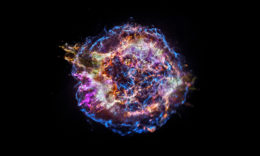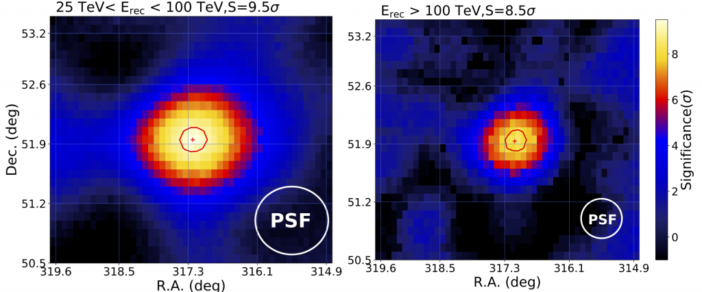Editor’s note: Astrobites is a graduate-student-run organization that digests astrophysical literature for undergraduate students. As part of the partnership between the AAS and astrobites, we occasionally repost astrobites content here at AAS Nova. We hope you enjoy this post from astrobites; the original can be viewed at astrobites.org.
Title: Discovery of the Ultra-high energy gamma-ray source LHAASO J2108+5157
Authors: Zhen Cao, F. A. Aharonian, Q. An, et al. (the LHAASO collaboration)
First Author’s Institution: Institute of High Energy Physics, Chinese Academy of Sciences, China
Status: Submitted to ApJL
The Hunt for PeVatrons

Figure 1: An image of the supernova remnant Cassiopeia A from NASA’s Chandra X-ray Observatory. [NASA/CXC/SAO]
However, we know that these particle accelerators exist. We know this because we are constantly being bombarded by high-energy cosmic rays — protons or heavier atomic nuclei that are traveling at nearly the speed of light. Now, over 100 years since Austrian physicist Victor Hess discovered cosmic rays by taking an electroscope on a hot air balloon flight, we still don’t know what astrophysical objects produce the highest energy cosmic rays. Some of these cosmic rays have an energy over 1 Petaelectronvolt (PeV = 1015 electronvolts), comparable to that of a mosquito’s kinetic energy, but packed into a single proton.
The cosmic objects responsible for producing PeV cosmic rays are so called “PeVatrons,” and pinpointing these sources is no small feat. However, as these cosmic rays are so energetic, they are akin to a bull in a china shop, and they frequently collide with gas or material that surround the PeVatrons. These interactions produce gamma rays that carry about 10% of the energy of the initial cosmic ray. Thus, finding gamma rays with energy of about one tenth of a PeV (100 TeV) is a smoking gun for a PeVatron.

Figure 2: Another aerial view of the Large High Altitude Air Shower Observatory (LHAASO). The cylindrical tanks help detect muons, which can be used to distinguish gamma rays from unrelated cosmic rays. [Liu Kun/Xinhua/Alamy]
Although LHAASO is not even done with construction, its immense size already makes it an extremely efficient gamma-ray detector. To date, LHAASO has detected 12 sources of these ultra-high-energy (UHE) gamma rays, and has even detected the highest energy photon from an astrophysical source yet found. While all of these sources provide a wealth of information on galactic PeVatrons, one of the objects — LHAASO J2108+5157, the focus of today’s paper — is particularly interesting because of its mysterious origins.
Figure 3 shows the detection of this object at energies between 25 TeV and 100 TeV, as well as for higher energies. The source is significantly detected in both of these energy ranges. However, what is strange is that while all of the other 12 sources have been detected by other telescopes in the “very-high-energy” band (around 1 TeV or so, which is high energy but still below the energy detection limit of LHAASO), this is the only object that is significantly detected at higher energies but does not have a counterpart at 1 TeV.

Figure 3: Significance map in the region around the newly detected source, LHAASO J2108+5157. The left shows gamma rays with energies between 25 TeV and 100 TeV and the right shows gamma rays above 100 TeV. The cross denotes the best-fit location of the source and the red circles show an approximate uncertainty on this location. The white circles show the average directional uncertainty for individual gamma-ray events. [Cao et al. 2021]
However, the authors note that this object is spatially coincident with a molecular cloud. Distinguishing between the molecular cloud scenario and the SNR or PWN scenario is crucial, as the presence of a molecular cloud could indicate this source is accelerating protons to these high energies. In the case of SNRs or PWNe, it is only believed that these objects might accelerate electrons (not protons) to high energies. The distinction between these two acceleration scenarios has dramatic implications for the spectra of cosmic rays. Figure 4 explores these two options by modeling what proton acceleration might predict versus electron acceleration. Although both models are consistent with the data, the authors believe the presence of a catalogued molecular cloud is promising for the proton scenario. Hopefully, future observations will be able to distinguish between these two cases.

Figure 4: LHAASO data (red) compared to various models that would predict gamma-ray emission. The solid red line shows a model based on the acceleration of protons (hadronic) and the dashed green is based on photons scattering off of accelerated electrons (leptonic, labeled IC CMB in the plot). Although the data are consistent with both, distinguishing between these models is crucial for finding the sources of the highest energy cosmic rays. [Cao et al. 2021]
Original astrobite edited by Katy Proctor.
About the author, Alex Pizzuto:
Alex is a PhD candidate at the Wisconsin IceCube Particle Astrophysics Center at the University of Wisconsin-Madison. His work focuses on developing methods to locate the Universe’s most extreme cosmic accelerators by searching for the neutrinos that come from them. Alex is also passionate about local science outreach events in Madison, and enjoys hiking, cooking, and playing music when he is not debugging his code.

